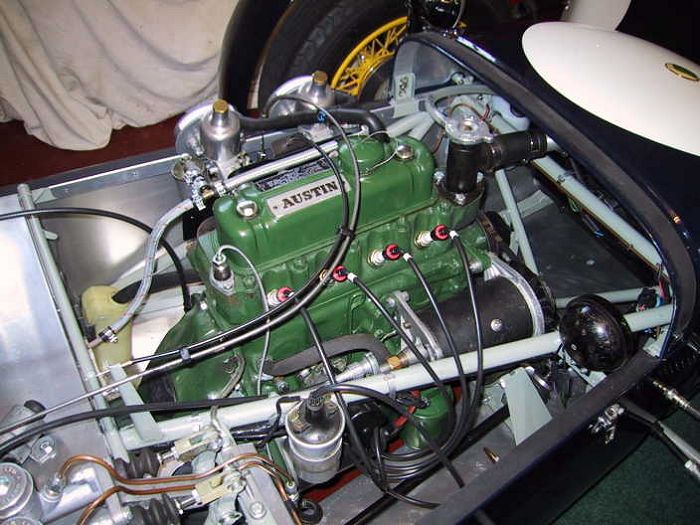Description
The Lotus Seven S1 BMC was the car that captured the essence of Colin Chapman’s design philosophy: simplicity, lightness, and pure driving pleasure. Introduced in 1957, the original Lotus Seven (Series 1) was the car that made the Lotus name accessible to private enthusiasts while setting the standard for the lightweight British sports car. The version powered by BMC’s small-displacement engines was particularly significant, as it embodied the perfect balance of affordability and performance—an elemental machine that offered the sensation of racing on the road.
The Seven S1 was born directly out of Chapman’s earlier Lotus Mark VI and the philosophy that “simplify, then add lightness.” It was designed as a road-legal sports car that could be used both for daily driving and weekend racing. The construction was ingenious in its simplicity: a lightweight tubular steel space frame clothed in aluminum body panels, with steel front wings and cycle-type fenders. The entire car weighed around 500 kilograms (just over 1,100 pounds), a figure that made it extraordinarily quick and agile even with modest engine power. The BMC-powered variants were among the most popular and lively of the early Sevens, offering excellent performance and handling at a relatively low cost.
Power for the Lotus Seven S1 BMC came from a range of small-displacement inline-four engines sourced from the British Motor Corporation. The most common unit was the 948 cc A-Series engine, the same basic powerplant used in the Austin A35 and later the Austin-Healey Sprite. Output varied depending on tune, but typically ranged from 37 to 43 horsepower in standard form—though Chapman offered factory kits and tuning options that could raise this figure substantially. Given the car’s featherweight construction, even this modest power allowed for 0–60 mph acceleration in under 14 seconds and a top speed of around 85 mph, with tuned examples comfortably exceeding 90 mph.
The engine was paired with a simple but effective four-speed manual gearbox, often from BMC’s parts bin, sending power to the rear wheels through a live rear axle. The car’s minimal weight and well-balanced chassis made it extraordinarily responsive, with immediate steering feedback and near-perfect handling balance. The suspension used unequal-length wishbones and coil springs at the front, while the rear featured trailing arms and a live axle with coil springs—a simple layout that provided excellent control and predictability on both road and track. Braking was by drum brakes all around, but given the car’s light mass, they were more than sufficient.
The Lotus Seven’s driving experience was unlike anything else on the road. The seating position was low and intimate, the steering wheel close to the chest, and the windscreen minimal—many owners even removed it for competition use. With no doors, no insulation, and only the barest hint of weather protection, the Seven put the driver directly in touch with every surface, sound, and motion of the car. The steering was razor-sharp, the throttle immediate, and the car’s behavior completely transparent. It rewarded smoothness and precision, making it as satisfying on a twisty B-road as it was on a racing circuit.
Stylistically, the Seven S1 was minimalist but elegant in its simplicity. The narrow aluminum nosecone with its oval grille became an enduring part of the car’s identity, a design element still present in modern Caterhams today. The long, exposed front suspension arms and cycle fenders gave it an unmistakably mechanical look—every component visible and functional. The cockpit was simple to the point of austerity: two bucket seats, a small set of Smiths gauges, and little else. Every ounce of unnecessary material was omitted in pursuit of lightness and performance.
The Seven S1 was offered as either a complete car or a kit to avoid the UK’s hefty purchase taxes, allowing enthusiasts to assemble their own Lotus at home. This approach not only made the Seven more affordable but also created a passionate community of builders and racers who would go on to form the backbone of Britain’s postwar motorsport scene. Many of these cars were modified, tuned, and raced in club events across the country, often outperforming far more expensive machinery.
The BMC-engined versions of the S1 quickly earned a reputation for reliability and tunability. The little A-Series engine was already well supported by the aftermarket, and owners often upgraded carburetors, camshafts, and exhausts to extract more performance. The combination of light weight, a rev-happy engine, and superb balance made the Seven unbeatable in its class. In the hands of skilled drivers, it could embarrass much more powerful cars on twisting circuits or hill climbs.
Production of the Lotus Seven S1 continued until 1960, with approximately 242 units built across all engine types. The BMC-powered versions were among the most numerous, as they offered the best balance between performance, affordability, and ease of maintenance. Later Sevens—the S2, S3, and S4—introduced refinements in chassis design and engine options, but the original S1 remained the purest expression of Chapman’s ideal.
Today, the Lotus Seven S1 BMC is revered as one of the most important and influential British sports cars ever made. It inspired an entire genre of lightweight roadsters and directly led to the creation of the Caterham Seven, which continues the lineage to this day. Collectors prize the early BMC-powered cars for their simplicity, purity, and historic significance, as well as their sheer joy to drive.
The Lotus Seven S1 BMC was more than just a car—it was a statement of intent. It proved that performance was not about power or luxury but about lightness, balance, and connection. It distilled the act of driving to its purest form, offering an experience that remains as exhilarating today as it was in 1957. In every sense, it was the essence of Lotus philosophy made tangible: minimal weight, maximum joy, and the road as the ultimate reward.

